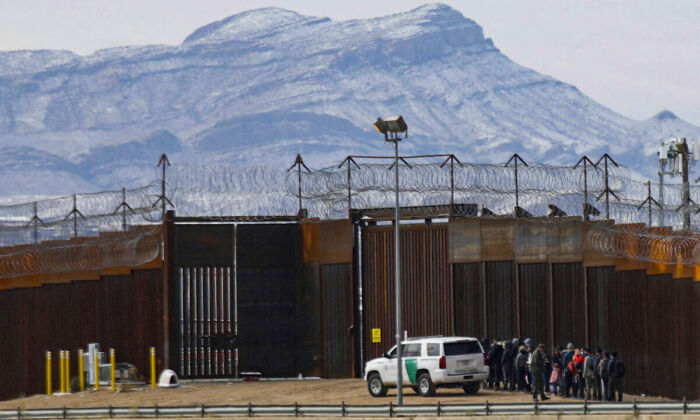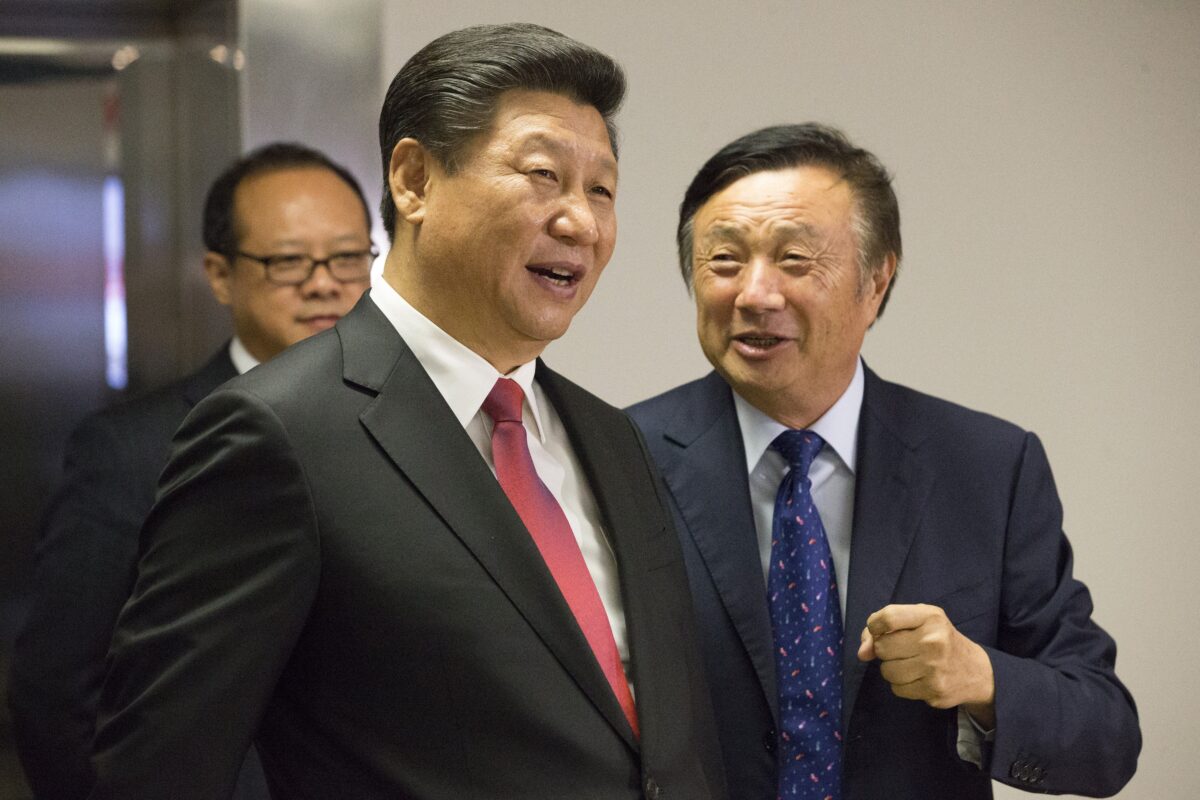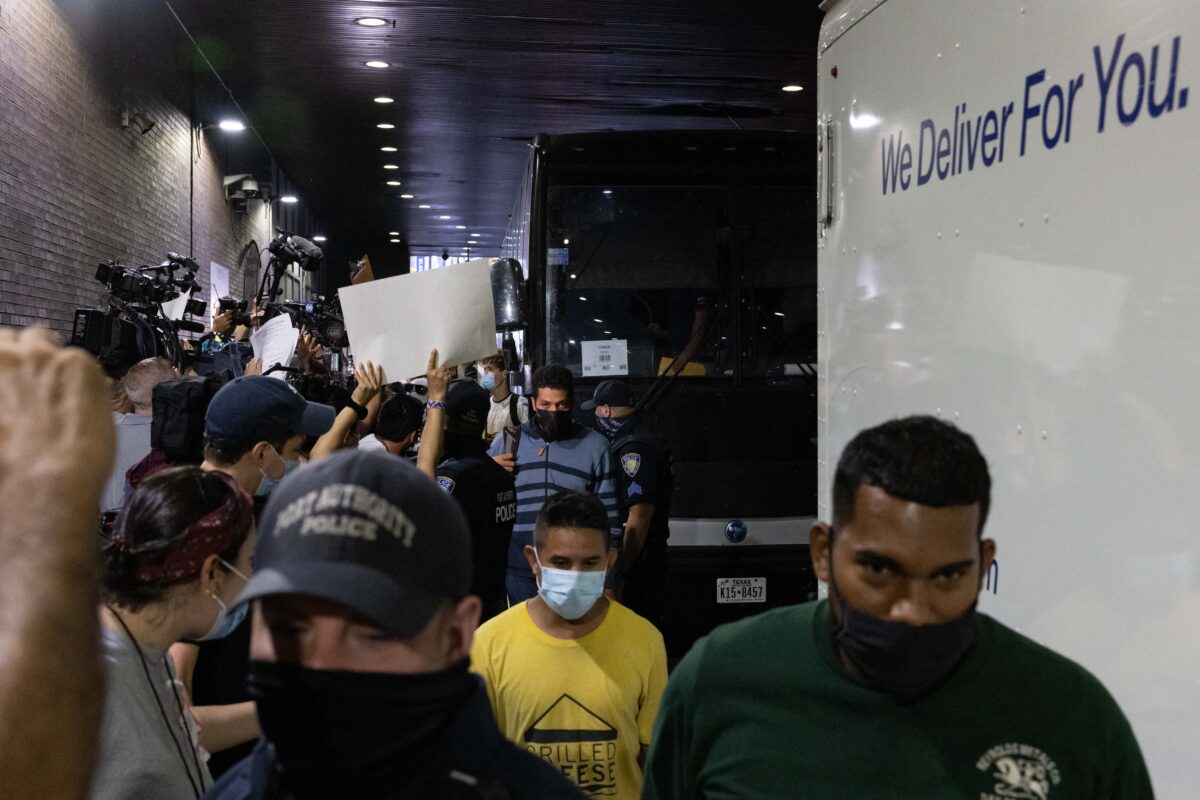Chinese Nationals Flood US Southern Border Amid CCP Espionage Concerns

Border Patrol agents detain a group of migrants near the border wall after they entered the United States from Ciudad Juarez on Feb. 3, 2022. (Herika Martinez/AFP via Getty Images)
By Autumn Spredemann
April 6, 2023Updated: April 7, 2023
In the wake of China abandoning its strict “zero COVID” policy, U.S. border officials have recorded a surge of Chinese immigrants crossing the southern border this year.
Between Oct. 1, 2022, and the end of February this year, U.S. Customs and Border Protection encountered nearly 3,000 Chinese nationals. This represents a more than 700 percent spike from the same period in 2022.
A second analysis by Axios put that number at more than 4,000 for 2023.
In February alone, there were 1,368 encounters with illegal Chinese immigrants. By contrast, U.S. border agents recorded just 55 encounters during the same month in 2022.
Epoch Times Photo

Chinese President Xi Jinping (L) is shown around the offices of Chinese tech firm Huawei technologies by its President Ren Zhengfei in London during his state visit on Oct. 21, 2015. (Matthew Lloyd/AFP via Getty Images)
Analysts say the deepening income gap in China combined with the Chinese Communist Party’s (CCP) draconian pandemic lockdowns is driving the surge in migration.
The ominous arrival of a new wave of Chinese illegal immigrants occurs against the backdrop of an ongoing battle against CCP agent espionage on American soil.
Since 2019, U.S. universities have become ground zero for spy activities involving CCP actors.
Reports of espionage and the unlawful exchange of information have been linked to at least five U.S. colleges across Texas, California, Kansas, Massachusetts, and Illinois in the past four years.
In October 2022, U.S. prosecutors charged 13 Chinese nationals for attempting to “unlawfully exert influence in the United States” on behalf of the CCP.
“No country poses a greater, more severe or long-term threat to our national security and economic prosperity than China,” FBI agent, Joseph Bonavolonta told reporters after a Texas professor was accused of spying for the benefit of the CCP.
He added, “China’s communist government’s goal, simply put, is to replace the United States as the world superpower.”
Sen. Ted Cruz (R-Texas) introduced legislation to stop Chinese spies in American education with the Stop Higher Education Espionage and Theft Act as a counter maneuver, saying, “China is the single greatest geopolitical threat facing the United States, and the CCP is a profoundly malign influence.”
Arriving in the wake of U.S. university spy attacks was the notorious spy balloon event earlier this year. On Feb. 4, U.S. military officials shot down an alleged Chinese surveillance balloon over the coast of South Carolina.
That was the same month Chinese illegal immigrant encounters at the U.S. southern border soared more than 900 percent.
Better Options
The United States grants asylum to Chinese nationals at a comparatively high rate. Government data shows 58 percent of Chinese illegals are given asylum upon request.
By contrast, Chilean and Brazilian asylum seekers are granted at a rate of 15 percent and 11 percent, respectively.
And while analysts say higher numbers of illegal immigrants from China carry similar risks as other groups, some think the CCP has better options for intelligence operations than asylum seekers.
“Illegal migration is not the optimal method for spies to get in because it’s risky, [and] attracts more scrutiny,” Irina Tsukerman, security analyst and founder of Scarab Rising, told The Epoch Times.
Tsukerman says illegal immigrants aren’t ideal for collecting the type of intelligence the CCP wants due to a high probability of legal entanglement and apprehension by border officials.
She says it’s Chinese nationals who arrive with legitimate U.S. visas who are the ones to watch.
“Legal migrants with ties to the home country, who are more likely to come back for visits, are better targets for intelligence recruitment—particularly if they have positions in universities, research labs, or companies where they may acquire influence or information desired by Beijing,” Tsukerman said.
Though she believes the wave of Chinese migrants heading for the U.S. southern border is problematic just the same.
Epoch Times Photo
United States Border Patrol agent Carlos Rivera is reflected in the window of a vehicle as he speaks to another agent along the border wall in downtown El Paso, Texas, on June 3, 2022. (Paul Ratje/AFP via Getty Images)
“The Chinese migrants crossing the southern borders carry the same risk as any other category of people. In the case of China’s gangs and organized crimes, the southern border has become a welcoming sign for fentanyl trafficking.
“Human trafficking often goes hand in hand with drug smuggling.”
But U.S. immigration attorney Min Hwan Ahn noted it’s important to avoid generalizing asylum seekers.
“Given last year’s incidents involving espionage charges against 13 immigrants, it is reasonable for legislators to be concerned about potential
security risks associated with illegal immigration from China,” Ahn told The Epoch Times.
As the founder of EZ485, a visa application and assistance service, Ahn has witnessed America’s immigration crisis up close. He asserts U.S. officials should strive to uphold national security, but maintain a compassionate approach to solutions.
“It’s crucial for authorities to strike a balance between ensuring national security and upholding humanitarian values when dealing with migrants seeking asylum or refuge,” he said.
“This includes thorough background checks and vetting processes while also providing necessary support for those genuinely
fleeing persecution or seeking better opportunities.”
Just The Beginning?
Motives aside, it appears the mass migration of Chinese nationals toward the U.S. border isn’t slowing down anytime soon.
In the first 60 days of this year, Panama border officials reported 2,200 illegal Chinese immigrants entering the country and heading north from the treacherous Darien Gap, a broad swath of jungle defining the border with Colombia that’s part of the migrant caravan route.
Some have cited the CCP’s pandemic response and the subsequent economic fallout as the impetus for the spike in Chinese nationals migrating overseas.
“The damage to the Chinese economy compared to four or five years ago is just so devastating for low-skilled workers,” Liang Zai, a U.S. sociology professor who also studies Chinese migration, told Axios reporters.
Others can’t bear to live another day in the shadow of the CCP’s COVID-19 lockdowns, which prompted Shanghai residents to scream for release in a haunting cacophony during an April confinement episode last April.
But Tsukerman said it’s important to remember, “Not everyone fleeing is doing so due to political repression.”
Though she said Beijing’s politics have definitely triggered the new wave of migration, “Pandemic policies, as well as the increasingly inward-looking political and economic restructuring, have had a significant impact on China’s economy.”
Ahn agreed with this sentiment.
“Political tensions and crackdowns on dissent within China may have prompted some individuals to seek asylum or refuge in the United States.”
https://www.theepochtimes.com/chinese-nationals-flood-us-southern-border-amid-ccp-espionage-concerns_5174617.html?src_src=News&src_cmp=breaking-2023-04-07-2&est=bskvlB6v%2FQYSJ44jt%2BqMtDICmpSbEe2pN5R1%2ByMEoJiFo0KZwyBOAoN0

Border Patrol agents detain a group of migrants near the border wall after they entered the United States from Ciudad Juarez on Feb. 3, 2022. (Herika Martinez/AFP via Getty Images)
By Autumn Spredemann
April 6, 2023Updated: April 7, 2023
In the wake of China abandoning its strict “zero COVID” policy, U.S. border officials have recorded a surge of Chinese immigrants crossing the southern border this year.
Between Oct. 1, 2022, and the end of February this year, U.S. Customs and Border Protection encountered nearly 3,000 Chinese nationals. This represents a more than 700 percent spike from the same period in 2022.
A second analysis by Axios put that number at more than 4,000 for 2023.
In February alone, there were 1,368 encounters with illegal Chinese immigrants. By contrast, U.S. border agents recorded just 55 encounters during the same month in 2022.
Epoch Times Photo

Chinese President Xi Jinping (L) is shown around the offices of Chinese tech firm Huawei technologies by its President Ren Zhengfei in London during his state visit on Oct. 21, 2015. (Matthew Lloyd/AFP via Getty Images)
Analysts say the deepening income gap in China combined with the Chinese Communist Party’s (CCP) draconian pandemic lockdowns is driving the surge in migration.
The ominous arrival of a new wave of Chinese illegal immigrants occurs against the backdrop of an ongoing battle against CCP agent espionage on American soil.
Since 2019, U.S. universities have become ground zero for spy activities involving CCP actors.
Reports of espionage and the unlawful exchange of information have been linked to at least five U.S. colleges across Texas, California, Kansas, Massachusetts, and Illinois in the past four years.
In October 2022, U.S. prosecutors charged 13 Chinese nationals for attempting to “unlawfully exert influence in the United States” on behalf of the CCP.
“No country poses a greater, more severe or long-term threat to our national security and economic prosperity than China,” FBI agent, Joseph Bonavolonta told reporters after a Texas professor was accused of spying for the benefit of the CCP.
He added, “China’s communist government’s goal, simply put, is to replace the United States as the world superpower.”
Sen. Ted Cruz (R-Texas) introduced legislation to stop Chinese spies in American education with the Stop Higher Education Espionage and Theft Act as a counter maneuver, saying, “China is the single greatest geopolitical threat facing the United States, and the CCP is a profoundly malign influence.”
Arriving in the wake of U.S. university spy attacks was the notorious spy balloon event earlier this year. On Feb. 4, U.S. military officials shot down an alleged Chinese surveillance balloon over the coast of South Carolina.
That was the same month Chinese illegal immigrant encounters at the U.S. southern border soared more than 900 percent.
Better Options
The United States grants asylum to Chinese nationals at a comparatively high rate. Government data shows 58 percent of Chinese illegals are given asylum upon request.
By contrast, Chilean and Brazilian asylum seekers are granted at a rate of 15 percent and 11 percent, respectively.
And while analysts say higher numbers of illegal immigrants from China carry similar risks as other groups, some think the CCP has better options for intelligence operations than asylum seekers.
“Illegal migration is not the optimal method for spies to get in because it’s risky, [and] attracts more scrutiny,” Irina Tsukerman, security analyst and founder of Scarab Rising, told The Epoch Times.
Tsukerman says illegal immigrants aren’t ideal for collecting the type of intelligence the CCP wants due to a high probability of legal entanglement and apprehension by border officials.
She says it’s Chinese nationals who arrive with legitimate U.S. visas who are the ones to watch.
“Legal migrants with ties to the home country, who are more likely to come back for visits, are better targets for intelligence recruitment—particularly if they have positions in universities, research labs, or companies where they may acquire influence or information desired by Beijing,” Tsukerman said.
Though she believes the wave of Chinese migrants heading for the U.S. southern border is problematic just the same.
Epoch Times Photo
United States Border Patrol agent Carlos Rivera is reflected in the window of a vehicle as he speaks to another agent along the border wall in downtown El Paso, Texas, on June 3, 2022. (Paul Ratje/AFP via Getty Images)
“The Chinese migrants crossing the southern borders carry the same risk as any other category of people. In the case of China’s gangs and organized crimes, the southern border has become a welcoming sign for fentanyl trafficking.
“Human trafficking often goes hand in hand with drug smuggling.”
But U.S. immigration attorney Min Hwan Ahn noted it’s important to avoid generalizing asylum seekers.
“Given last year’s incidents involving espionage charges against 13 immigrants, it is reasonable for legislators to be concerned about potential
security risks associated with illegal immigration from China,” Ahn told The Epoch Times.
As the founder of EZ485, a visa application and assistance service, Ahn has witnessed America’s immigration crisis up close. He asserts U.S. officials should strive to uphold national security, but maintain a compassionate approach to solutions.
“It’s crucial for authorities to strike a balance between ensuring national security and upholding humanitarian values when dealing with migrants seeking asylum or refuge,” he said.
“This includes thorough background checks and vetting processes while also providing necessary support for those genuinely
fleeing persecution or seeking better opportunities.”
Just The Beginning?
Motives aside, it appears the mass migration of Chinese nationals toward the U.S. border isn’t slowing down anytime soon.
In the first 60 days of this year, Panama border officials reported 2,200 illegal Chinese immigrants entering the country and heading north from the treacherous Darien Gap, a broad swath of jungle defining the border with Colombia that’s part of the migrant caravan route.
Some have cited the CCP’s pandemic response and the subsequent economic fallout as the impetus for the spike in Chinese nationals migrating overseas.
“The damage to the Chinese economy compared to four or five years ago is just so devastating for low-skilled workers,” Liang Zai, a U.S. sociology professor who also studies Chinese migration, told Axios reporters.
Others can’t bear to live another day in the shadow of the CCP’s COVID-19 lockdowns, which prompted Shanghai residents to scream for release in a haunting cacophony during an April confinement episode last April.
But Tsukerman said it’s important to remember, “Not everyone fleeing is doing so due to political repression.”
Though she said Beijing’s politics have definitely triggered the new wave of migration, “Pandemic policies, as well as the increasingly inward-looking political and economic restructuring, have had a significant impact on China’s economy.”
Ahn agreed with this sentiment.
“Political tensions and crackdowns on dissent within China may have prompted some individuals to seek asylum or refuge in the United States.”
https://www.theepochtimes.com/chinese-nationals-flood-us-southern-border-amid-ccp-espionage-concerns_5174617.html?src_src=News&src_cmp=breaking-2023-04-07-2&est=bskvlB6v%2FQYSJ44jt%2BqMtDICmpSbEe2pN5R1%2ByMEoJiFo0KZwyBOAoN0






















